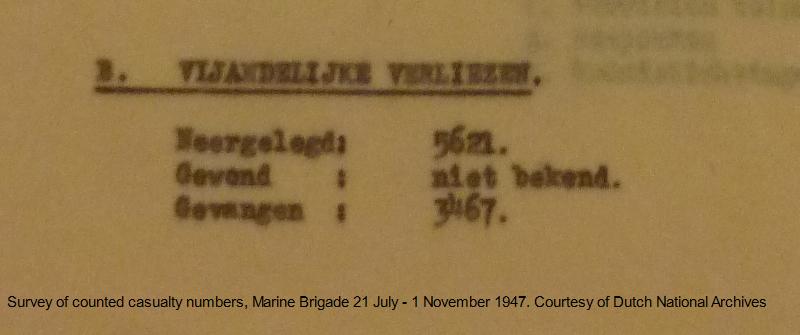
26 May Blog: 100.000: the magic victim number
Historian Bart Luttikhuis examines the origins of the widely-used estimate of 100,000 Indonesian victims of the Dutch-Indonesian War of Decolonization (1945-1950), and calls into question its accuracy. Ultimately, he wonders, does the number really matter?
Why is it that humanitarian tragedies seem more tragic if we can quantify them?
Unsolved questions surround the number of victims in the Dutch-Indonesian War of Decolonization. Dutch military casualties have been meticulously registered and come to either just under 5000 or around 6000 (including victims of accidents and illness), depending on how you count. (Indo-)European civilian victims of Indonesian violence number either between 5000 and 10,000 or between 20,000 and 40,000, depending on who you ask. But the most uncertainty remains around the number of Indonesian victims, both of Dutch military violence and of internal Indonesian conflicts.
Somehow, that uncertainty seems morally unacceptable to many. Therefore, in recent years, the number of 100.000 Indonesian victims has gradually taken hold among historians. As compelling as this number may be, it is entirely unfounded in archival research. The military reporting in the Dutch archives sometimes (but not always) includes statistics on ‘enemy victims’. These are incomplete and highly unreliable (they might be both underestimations or exaggerations) but they are the only extensive data that we have. If these numbers are to be believed, 100,000 would be a gross underestimation. For example, Petra Groen in her book Marsroutes en Dwaalsporen (1992) calculated that just in the first half of 1949 no fewer than 50,000 Indonesian victims were registered. And as my colleague Christiaan Harinck and I found (see photo), the Marine Brigade alone claimed to have killed (“neergelegd”) 5621 Indonesians, in a period of just over three months in 1947, in East Java alone.
Where did the 100,000 number come from? It all started with Loe de Jong, who in a footnote to his Koninkrijk der Nederlanden in de Tweede Wereldoorlog claimed that 100,000 was the generally accepted number used ‘in Indonesia’. De Jong cited no sources, and merely claimed: ‘Dutch military historians’ – no names are provided – ‘regard this as a reliable number’. The career of ‘100.000’ really took off when, several years ago, it was included in a webpage of the NIOD Institute for War, Holocaust and Genocide Studies. Many authors looking to quickly put a number on the Indonesian death toll ended up here (in all honesty: myself included).
One has the strong suspicion that De Jong simply pulled the number out of a hat. ‘100,000’ turned out to be a good number for his magic trick: it was a nice round figure, it was large enough to signal that we’re dealing with a ‘serious’ war, but it was also small enough that no one asked to see the statistics. As De Jong’s number found its way into the works of others, his claim that ‘historians’ regard it as ‘reliable’ gradually became a self-fulfilling prophecy.
When writing about a war, we seem to find it unacceptable to be unable to quantify the victims. But in the case of Indonesian victims of the decolonization war, the simple fact of the matter is that the surviving documentation makes that impossible. The number might be lower than De Jong’s 100,000, or (quite likely) it might be several times as high. Does that make the war any more or less tragic?
(Bart Luttikhuis is a researcher at KITLV in late colonial history and the history of decolonization, with a particular empirical focus on early twentieth century Indonesia. He is affiliated with the project ‘Dutch military operations in Indonesia, 1945-1950’, which explores the forms and functions of violence and atrocities during the Indonesian war of independence.)




Adrian Vickers
Posted at 16:04h, 27 MaySee my History, I give a lower estimate of 45,000 altogether, but the suspicious rounded figures go up to 200,000.